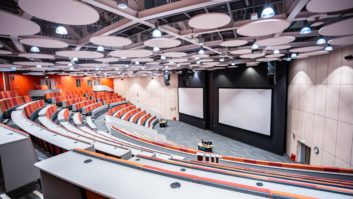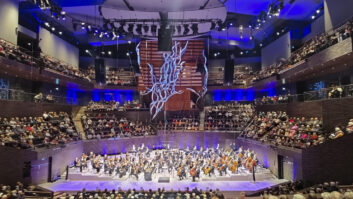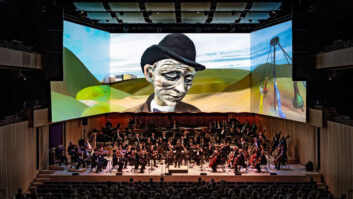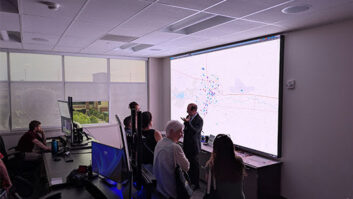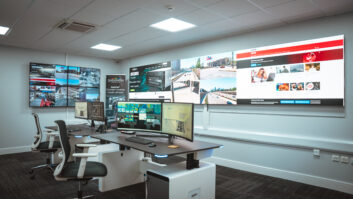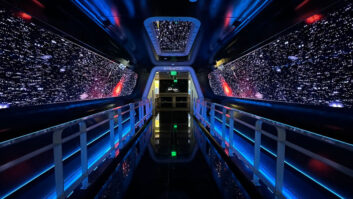The National Automotive Innovation Centre (NAIC), a joint collaboration between Warwick Manufacturing Group, TATA and Jaguar Land Rover, is one of Europe’s largest advanced automotive research, design and development facilities.
The 33,000m² centre features an Industrial Design Hub dedicated to optimising collaboration, cultural change and digital transformation, removing the barriers that slow down traditional manufacturing as it transitions into the virtual space.
This is being achieved using an array of advanced emerging technologies, complex AV and tracking solutions designed and installed by reality integrator Holovis. These are seen as the catalysts that will mobilise digital and immersive technologies within the industry to aid in the development of crucial future sustainable travel.
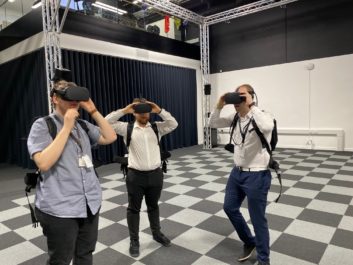 The Hub features the UK’s largest industrial tracked space, a 14m x 14m free roaming area that enables designers, engineers and manufacturers to interact with virtual models using virtual, augmented and mixed reality. Users are mapped in the environment through an optically tracked rig that surrounds the platform. The 36 OptiTrack cameras ensure highly accurate tracking with ultra-low latency, so everything moves in real-time for the users and to their unique perspective.
The Hub features the UK’s largest industrial tracked space, a 14m x 14m free roaming area that enables designers, engineers and manufacturers to interact with virtual models using virtual, augmented and mixed reality. Users are mapped in the environment through an optically tracked rig that surrounds the platform. The 36 OptiTrack cameras ensure highly accurate tracking with ultra-low latency, so everything moves in real-time for the users and to their unique perspective.
This is run by a proprietary software suite created by Holovis which renders the virtual environment for the simultaneous users, splitting the tracked space into multiple sections and enabling easy calibration of devices.
The space has been designed to be hardware agnostic, futureproofing it for technology advancements. Currently, the Vive Pro, Oculus, Hololens 2 and iPad Pros are being used as the windows into the virtual space, utilising portable systems that allow them to move freely and safely around the area. From a software perspective, the Hub runs on an open source mentality with a two-way communication stream with partners including Microsoft, Google, and Unity, sharing developments allowing them to advance their own offering.
A rear projected portable Power Wall featuring a Barco F70 projector allows for collaborative sessions in an immersive environment and a smaller tracked area that features three Barco F80-Q7 projectors creating content on three walls to facilitate group immersion into a virtual space.
The multisensory immersion is completed with a 12.1 surround sound system that can be driven to complement the content. Factory spaces for example can be enhanced with a realistic ambience. This can also be mixed directly into the headsets.
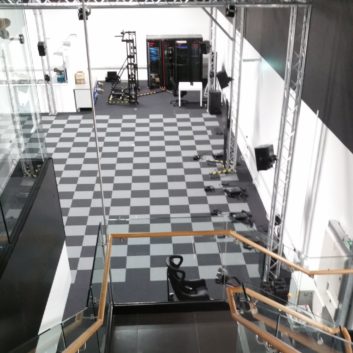 The design facility is a unique creation within the industrial design sector, allowing for multiple use cases that span across the whole advanced engineering and virtual manufacturing sphere, and even into retail using the same robust data set.
The design facility is a unique creation within the industrial design sector, allowing for multiple use cases that span across the whole advanced engineering and virtual manufacturing sphere, and even into retail using the same robust data set.
Current use cases include ergonomics for measuring reach and comfort levels; visualisation of new product designs, site layouts and manufacturing production lines for analysis prior to build and installation; and H&S to simulate the processes for new build areas in a risk free environment and facilitating global collaboration and connectivity.
The technology solution is set to make advancements in environmental savings in comparison to traditional manufacturing methods. Users from around the world will be able to dial in to the same datasets, working together in real time from multiple devices including desktop, VR and MR. This will reduce travel both globally and between UK based sites by enabling true virtual collaboration. The advanced visualisation techniques will start to reduce the number of physical models that need to be created by making data sets that are just as compelling that can be interrogated and instantly updated, speeding up development cycles as well as Giving more choice to the customer
The Industrial Design Hub was a 2.5 year process from initial design to installation, working closely with Digital Pioneer Brian Waterfield, to bring his vision to life. It is designed to futureproof additional digital transformation advancements, with the next planned installment the integration with AI, complex IoT and human in the loop design. The technology and proprietary software suites are enabling the transition of manufacturing into the digital world.
Professor Alan Chalmers of the University of Warwick and Warwick Manufacturing Group, said, “The IDH is a real centre of excellence for motion capture. Their leading-edge equipment includes an OptiTrack 14m×14m motion area which allows you to walk around without restriction.
“Furthermore, the centre will have a key role to play as a facility to enable users to interact seamlessly with Digital Twins; a key part of Industry 4.0 strategy,” he said. “New tools that will be able to be developed in such a rich environment will make a significant contribution in closing the gap between the latest academic research and essential industrial needs.”
Brian Waterfield, digital manufacturing manager and high-end visualisation and immersive lead, Jaguar Land Rover, added, “Over the past 14 years I have pioneered digital development in industry, with a strong focus on utilising current and evolving immersive technology, to maximise process and product. The Industrial Digital Hub is the latest tool box to address the accelerating marketplace, and the growing technology landscape; a collected of possibilities that will answer the question not yet asked.
“Holovis has managed to take this vision and create the platform for research and development within the digital field, enabling academia and industry to stand together and progress the ecosystem required to sustain not only business but help tackle the increasing pressures on our environment. Smart system architecture, clever interpretation, and dedicated creativity, has realised the picture I have in my head, taking the concept to reality and making digital reality a when, no longer a how.”
